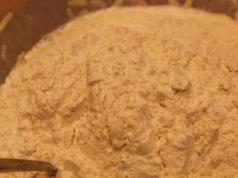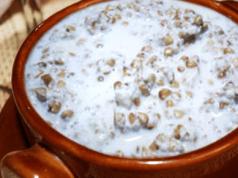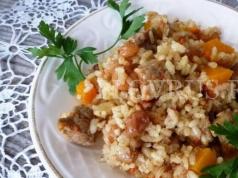Let's just say that a knife is an extremely necessary thing, and if it so happened that you were alone with nature, you don’t have a knife, but there’s nowhere to go without it! Use the experience of our ancestors and try to make a knife out of stone.
In theory, everything is quite simple, you need to find a suitable stone and process it in such a way that it has a cutting surface.
To do this, the stone must be split into plates and sharpened if necessary. As tools for making and sharpening, you can use another stone, bone, animal horn, and everything else with which you can give our knife the desired shape and sharpness, in this sense it would not be bad to practice in advance.
For manufacturing, it is best to use stones of the following breeds:

Slates- various rocks with a parallel (layered) arrangement of intergrowths of low- or medium-temperature minerals. Shales are characterized by schistosity - the ability to easily split into separate plates. They belong to terrigenous or metamorphic rocks.

Flint- a mineral formation consisting of crystalline and amorphous silica (SiO 2) in sedimentary rocks. Often painted with iron and manganese oxides in different colors, with smooth transitions between them.
In ancient times, flint fragments were used to strike fire, make weapons and household items (arrowheads, flint knives, etc.) In the Middle Ages, flint was widely used to make fire by striking sparks on tinder using two pieces of flint, or one flint and a piece of other material (flint-pyrite, flint-steel). Later it was used in weaponry in wheel and shock flint gun locks.

Quartz- one of the most common minerals in the earth's crust, a rock-forming mineral of most igneous and metamorphic rocks.

Obsidian- igneous rock, consisting of volcanic glass with a water content of not more than 1%, homogeneous volcanic glass that has passed through the rapid cooling of molten rocks. Volcanic glasses that are richer in water and swell when heated are referred to as perlites.
You can make your knife a wooden handle (by tying the blade to wood with string) or use it as is. The undoubted advantage of a stone knife is its sharpness, it is also not subject to corrosion, but in terms of strength it is not very good, it can break from a fall or impact.
© SURVIVE.RU
Post Views: 3 773
Simple home-made piercing and cutting weapons made of stone, wood and bone can be made on your own when surviving in extreme conditions, but for this you need to have at least a little experience in making it and at least small skills.
Homemade stone knife.
The material for a homemade stone knife can serve.
Obsidian is an igneous rock composed of volcanic glass.
— Quartz is a widespread, hard, rock-forming mineral. Has many varieties.
- Flint - painted in different colors, with smooth transitions between them. Excellent material for making knife, axe, spearhead, arrowheads.
Shales are rocks. Easily split into separate, thin and sharp plates.
Making a homemade stone knife.
Rinse the selected stone (layered rock) with water. Then determine the presence of natural cracks in it and their general direction. In these directions, the stone will easily split into plates. Hit a stone with another stone so that the impact energy travels along the layer or crack. It is impossible to process a stone in other directions, that is, across cracks and layers.
The broken-off plate must be given the desired shape of the knife with the help of another stone. If the size of the plate allows, then make a handle. The size of the handle is the size of the palm. Wrap the handle with a cloth, leather strip, and the like. If the stone handle did not work out, then you need to cut it out of a tree branch. Split the end of the branch. Insert the blade into the split and securely fasten it there by wrapping the handle with wire, rope, strips of fabric, bandage, leather belt, liana.
Homemade spear.
A spear is a piercing or piercing-chopping, throwing, pole cold weapon. A spear is the same knife, only with a long, straight handle. The simplest spear is a straight stick made of hard wood sharpened from a thicker end. For hardness, the tip of the spear should be on the fire. For defense against a predator at close range, a short, strong, sharpened branch may come in handy. For greater efficiency, the spear must be equipped with a tip made of stone, bone, metal.

Homemade horn.
Rogatin is a Slavic heavy spear for hunting large game. A simple horn is a thick, pointed, long stake. The horn has no resemblance to a pitchfork, it is called so because, in ancient times, a horn from cattle served as its tip. Or a horn is a wide two-blade knife on a long shaft. Designed to repel the attack of an attacking animal (bear, tur, wild boar). The thickness is equal to the grip of the palm of the hand. The length is about two meters. Below the tip, you need to fix the cross, to keep the beast at a safe distance. When attacking an animal, the horn should be quickly rested with a blunt end on the ground, step on it with your foot and put the tip in the direction of the animal. When hit, the horn must be held with both hands.
Homemade stone axe.
The material used is the same as for the blade of a stone knife: flint, obsidian, etc. A simple way to make an ax is to beat the stone to the desired shape and form a sharp blade. Then the finished stone must be attached to a handle made of durable wood.

Homemade sling, harpoon.
Sling - this weapon is a long harpoon for spearfishing. On the one hand it has a tip to hit the fish. On the other hand, rubber or spring traction. The hitting distance is limited by the length of the harpoon.

Homemade fighter.

Drach is designed for fishing at depth from the shore or from a boat. The order of fishing: throw the drach to the bottom of the reservoir further from the shore, and preferably in a hole. Wait a little, then with a sharp jerk for the rope, pull the tackle towards you. If the fish was not hooked, repeat. Principle of operation: due to a sharp jerk, the drach randomly breaks off the bottom and catches fish on its way with hooks.
Based on the book "Survival beyond the threshold of civilization."
Nagorsky S.V.
It was enough for Mowgli to acquire an "iron tooth", and half of his problems were solved, which as a result led him to the throne of the wolf pack. And this is no joke: the presence of a knife in a survival situation immediately increases the chances of success by at least 50%. But even if such a product is not among your things, you can make a knife yourself, and not only from metals.
The ability to build a knife depends on the available resources and the conditions of the area in which the person found himself. Almost everywhere you can find natural material for the manufacture of blades of various types.
Pay attention to rocks. Obsidian (volcanic glass), quartz, flint, shale (layered material) are suitable for making a knife. The stone is shattered against the rock by a 90-degree impact, resulting in a sharp edge that can be processed further or left as is. Such a product will allow you to cut the rope, finish off the game, build an ax, etc.


In forests, flakes from hardwoods (such as oak or coniferous trees) are used to create a cutting edge. Such wood is characterized by good strength, which increases along with the sharpness of the “blade” after firing. A wooden knife can be wrapped with a rag or other material to create a handle. The application is almost similar to stone - it’s suitable to butcher the carcass and cut the rope. It is better to have several of these items with you.
If you are near a river or other body of water, shells such as toothless ones can help. The half of such a shell has a good cutting edge.
In the sands, saxaul can play the role of a knife. It is also worth paying attention to the shells of turtles. This chitinous "body armor" consists of shale-like plates that can be used as a knife.
If you are a successful hunter, and you come across a medium-sized animal, a knife can be built from ribs by turning one of the edges on a stone. Tibia bones are also suitable for this. In addition, sometimes other natural materials can play the role of a knife. For example, a sedge leaf will allow you to quickly clean the mushroom for boiling.
Now a few words about metal. Many people get into accidents without a knife, but with enough other materials. To make a blade in this case, it is necessary to choose a pliable (soft) metal, and process it with a weighty object resembling a hammer (for example, a large nut with an ax handle threaded into the hole, etc.). Processing is carried out on a flat surface (for example, on a flat stone), where the product is given the necessary shape and the cutting edge is removed. The handle is made from wood. Of course, this is not a steel knife, but it will perform household functions tolerably.
Any piece of metal or other material can be used as a knife. For example, a bent lid of a can, half of which is wrapped in cloth, or a long piece of glass, for which a rope or rag “handle” is also made. The main thing is not to get confused and show your imagination and ingenuity.
After the next viewing of the movie "Hunted", I wanted to remember my childhood and again make myself a knife out of stone. In the near future I will definitely do this, but for now a little theory ...
These three drawings show the three stages of making a flint knife.
1. Rough processing of a flint blank with a stone impactor.
2. Careful finishing of the flake with a softer striker made of bone or horn.
3. Fine-tuning of the knife blade by pressing.
Production materials:

Obsidian- homogeneous volcanic glass that has passed through the rapid cooling of molten rocks. Obsidian can be found in the Aeolian Islands, Iceland, the Caucasus, Siberia and Kamchatka.

Quartz- one of the most common minerals in the earth's crust, a rock-forming mineral of most igneous and metamorphic rocks. 12 percent of the earth's crust is made up of quartz. 
Flint- nodules of silica (SiO2) in sedimentary rocks. Often painted with iron and manganese oxides in different colors, with smooth transitions between them

Slates- rocks, with a parallel (layered) arrangement of the minerals that make up their composition. Shales are characterized by schistosity - the ability to easily split into separate plates.
And so let's start, we take a suitable stone, it should be one and a half times larger than the planned tool and not have cracks.
With a blow of a hard smooth stone, split the workpiece so that a flat surface is formed. The impact should be applied at an angle less than 90°. After a good blow, you should get a flat chip with a cutting edge, if this is enough for us, we can cut, since the edge is sharp.
If you want to give a certain shape, then you should take a bone or hard wood and “cut” a little, the main thing here is to be careful and not rush anywhere.
The handle can be wrapped with improvised materials (leather, fabric, young bark) or the resulting blade can be fixed in wood or bone and wrapped in the same way. You can also put it on glue, I will tell you how to make it a little later ... 
I want to say that you can’t open a tin can with such a knife, but here you can remove the skin, cut the rope, finish off the beast, or if you make a stone ax then cut down the tree
I hope the material will be useful to someone. I collected pieces from memory and the Internet helped and advised me in this :)
P.S. Dear, if you are "-", then write why, just wondering
The question is how to store ground coffee at home, gets up in two cases. When the grains are ground on their own in a larger quantity than required for the preparation of the drink. And when the vacuum packaging from the store is opened. Whole grains retain their flavor longer, so it's best to grind them just before cooking. The storage of ground coffee has its own characteristics, which we will discuss further.
Selection rules
Ground coffee is sold, as a rule, packaged in vacuum packaging. With the exception of special bags for single tea leaves. When purchasing vacuum packaging, you should pay attention to the integrity of the outer layer, and also check whether the contents are well compressed. The packaging must be tightly packed (firm and tight to the touch).
Ground coffee storage conditions
Ground coffee should be kept in a dry, tightly sealed container, protected from direct sunlight and electric light. It is advisable to remove the vessel away from the stove and sink in order to eliminate the factors of hot steam and excessive moisture. Storage temperature - room temperature, or slightly lower. If for any reason the room is constantly hot, then the container can be kept on a shelf in the refrigerator door.
Thus, optimal conditions storage is:
- temperature from +8 to +23˚C;
- air humidity 50-60%.

Where to store ground coffee
It is better to keep a package with a fragrant drink in a closed cabinet, away from spices and other products with a strong smell. When ground, grains tend to quickly lose their aroma and absorb foreign odors. If a larger portion is ground than it took for one cezve (Turks) or a French press, then you should not leave unused powder in the coffee grinder. It is better not to be too lazy and transfer it to a glass container, although coffee ground at home will lose its aroma and taste qualities already in a couple of days.
What to store
On sale there are special vacuum packaging and multi-layer bags with valves. You can store ground coffee in foil bags. In this case, placing it there, it is necessary, squeezing the bag with your hands, try to release all the air, and carefully roll the bag. It is also acceptable to keep this product in opaque glass jars, and in ceramic containers coated on the inside with glaze. All this should be closed with tight, airtight lids.
The shelf life of ground coffee in unopened packaging is up to 1 year. Opened packages must be tightly closed. The less grain or ground powder comes into contact with air, the longer it will be fragrant. Take the powder only with a dry spoon.
Shared storage table
| Type of beans or packaging |
Temperature |
||
| 0˚- -20˚C | |||
| green grains | 1 year | 1.5 years | 10 months |
| Cereal in closed packaging | 1 year | 1.5 years | no more than six months |
| Cereal in open package | up to 10 days | unacceptable | no more than a week |
| Freshly ground in opened packaging | no more than 2 days | unacceptable | several hours |
| Ground in sealed packaging | about a year | 2-3 years in sealed packaging | up to six months |
| Soluble (in manufacturer's packaging) | up to 3 years | up to 5 years | no more than a year |
| Soluble (after opening the package) | 4-5 months | unacceptable | 3 months |
According to the rules, when preparing ground coffee in a cezve, you should first add the powder. And then pour it very cold water(This important condition good coffee). You can add a small pinch of salt or cinnamon to the coffee being prepared on the stove. It will be delicious - if you add cardamom and cloves. If you want to make a sweet drink, then sugar is added immediately during preparation, so that later, when stirring with a spoon, do not disturb the beautiful foam in the cup.








